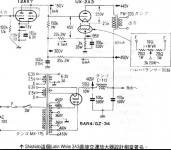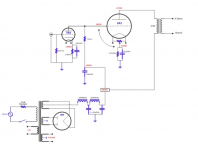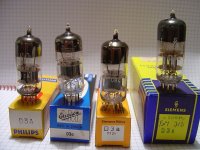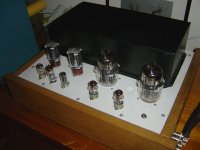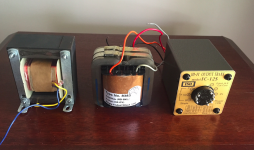
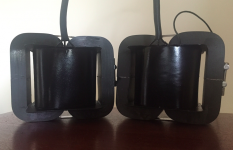
First Post on DC coupled Single Ended 2A3/6A3 amplifier construction.
My List of Transformers and current builds
Electra-Print 65mA output transformers 2.5K / 8 ohm
Custom Built M3 Grain Orientated Double C core 2.5K/3.5k/4.8.16 ohms
Amorphous Custom Built Double C core 2.5K/8 ohms
ISO ( Tango ) HiB Cut Core FC12S Multiple Primaries and secondaries
All perform very well indeed ,but exhibit different qualities and tonal characte
I will post pictures and performance data as the thread grows and comments get posted
Above images - L to R - Electra-Print - Custom Made Double C core Amorphous - ISO ( Tango) New FC12S model and next a pair of M3 Grain Orientated Silicon Steel Double C cores
The purpose of this thread is to share information and idea's for the more skilled DIYers able to tackle Direct Coupled Driver and Output stage tweaking for best linearity and performance
Below a couple of well used schematics
Attachments
Last edited:
I have built several direct coupled 2A3/300B amplifiers and each has been great sounding. With a high quality output transformer, the sound is clear and authoritative. I have used both triode connected pentodes, e.g. D3a and E180F, as well as high mu low transconductance triodes such as the 6K5 and 6F5. I enjoyed all of these tubes and amps using the Electraprint 3k ohms and Tamura 5002 (amorphous core) also 3k ohms.
In fact, I have built an amplifier almost exactly like the 7B4/2A3 amp for which you show the schematic except that I used the 6K5 (mu = 70) rather than the 7B4. This amp was extraordinarily clean sounding, perhaps the cylindrical plate of the 6K5 contributes to the great sound. I would encourage you to try this tube and topology.
Note that the 2A3 cathode resistor bypass capacitor has to be a high quality MKP 4, or at least bypassed by an MKP.
The triode connected pentodes like the D3a sound great about 15mA biased by an LED at about -1.6V with a plate voltage about 150V. I would encourage you to try the different driver tubes.
In my experience comparing similar tubes but alternating from direct coupled to RC coupled, there was really no comparison. The DC amps were much cleaner.
In fact, I have built an amplifier almost exactly like the 7B4/2A3 amp for which you show the schematic except that I used the 6K5 (mu = 70) rather than the 7B4. This amp was extraordinarily clean sounding, perhaps the cylindrical plate of the 6K5 contributes to the great sound. I would encourage you to try this tube and topology.
Note that the 2A3 cathode resistor bypass capacitor has to be a high quality MKP 4, or at least bypassed by an MKP.
The triode connected pentodes like the D3a sound great about 15mA biased by an LED at about -1.6V with a plate voltage about 150V. I would encourage you to try the different driver tubes.
In my experience comparing similar tubes but alternating from direct coupled to RC coupled, there was really no comparison. The DC amps were much cleaner.
I didn't do a detailed analysis, but the 2A3 cathode connection in the first schematic appears to protect the 2A3 grid from seeing the full rail voltage, if the input tube fails or is disconnected. You can accomplish the same thing for the second design, by adding a zener string from the 2A3 grid to ground (zener string set a little higher than the maximum positive swing needed).
Sheldon
Sheldon
I do have some STC 5A/170K > CV3998> E180F tubes they are very nice sounding in triode , but prefer the high mu low transconductance triodes like the 6SF5 DC coupled in to a 6B4G run with Rod Coleman constant current DC supplies , very similar to Tentlabs but smaller and cheaper.
These old Sylvania's are well mage and sound very nice into a set of ISO Tango FC12S transformers biased back to 55mA
ISO tend to be a but expensive except for this model.
Electra-Print have the edge on bass response with M19 steel but the ISO better in the mids and highs with still good bass response
Amorphous core I have made here in Australia are also very nice ,but need double C core sizes of AMCC 63 and above even for 2A3 tubes at 60mA
These old Sylvania's are well mage and sound very nice into a set of ISO Tango FC12S transformers biased back to 55mA
ISO tend to be a but expensive except for this model.
Electra-Print have the edge on bass response with M19 steel but the ISO better in the mids and highs with still good bass response
Amorphous core I have made here in Australia are also very nice ,but need double C core sizes of AMCC 63 and above even for 2A3 tubes at 60mA
With transformer output, the last thing you need is DC coupling. The lower frequency must be limited for the inductance of the transformer otherwise the output valve will work hard to just heat up the copper windings.
I agree with what you say Jon, but have never had a problem with this. I've been using quite inexpensive china 2a3's as well.
I've been using a gyrator cascoded CCS on the input/driver. This keeps the grid at a very firm DC and I am very happy. I can pull the 2a3 during operation if I want, and nothing bad happens. I've been using triode strapped c3g as input/driver.
The other nice thing about the gyrator, is that you can also use the mu-follower output. Of course this puts some sand in the path, but when done well the results are quite acceptable (to me at least).
Hi soulmerchant,
It is hard to beat the German post small-signal tube as an input/driver (C3g, C3m, D3a .... etc).
What is the input voltage in your DC C3g-2A3 amp for maximum output power?
About 1Vrms, or so ??
Maybe C3m would be more applicable, imho.
For me, in amplifier good input/driver stage is more important than Oriented HiB, Amorphous or M3 grain oriented core in OPT.
It is hard to beat the German post small-signal tube as an input/driver (C3g, C3m, D3a .... etc).
What is the input voltage in your DC C3g-2A3 amp for maximum output power?
About 1Vrms, or so ??
Maybe C3m would be more applicable, imho.
For me, in amplifier good input/driver stage is more important than Oriented HiB, Amorphous or M3 grain oriented core in OPT.
Last edited:
I tend to use a pair of Sprague V735P 10uf/400v in parallel on the 2A3 cathode .
They are excellent in this position and have been the main stay of Yamamoto amps for years
Mouser lists them as no longer manufactured.
soon 10uF/400v from Mouser
now CDE 735P
Cornell Dubilier 735P Series Film Capacitors | Mouser Australia
I have a box of NOS Sprague V735P 10/400
now CDE 735P
Cornell Dubilier 735P Series Film Capacitors | Mouser Australia
I have a box of NOS Sprague V735P 10/400
Driver stage sets the stage for the rest of your amplifier
And the input stage sets the stage for the driver stage.... lol sorry couldnt resist.
- Status
- This old topic is closed. If you want to reopen this topic, contact a moderator using the "Report Post" button.
- Home
- Amplifiers
- Tubes / Valves
- Single Ended 2A3/6A3/6B4G DC coupled & Transformer choices
